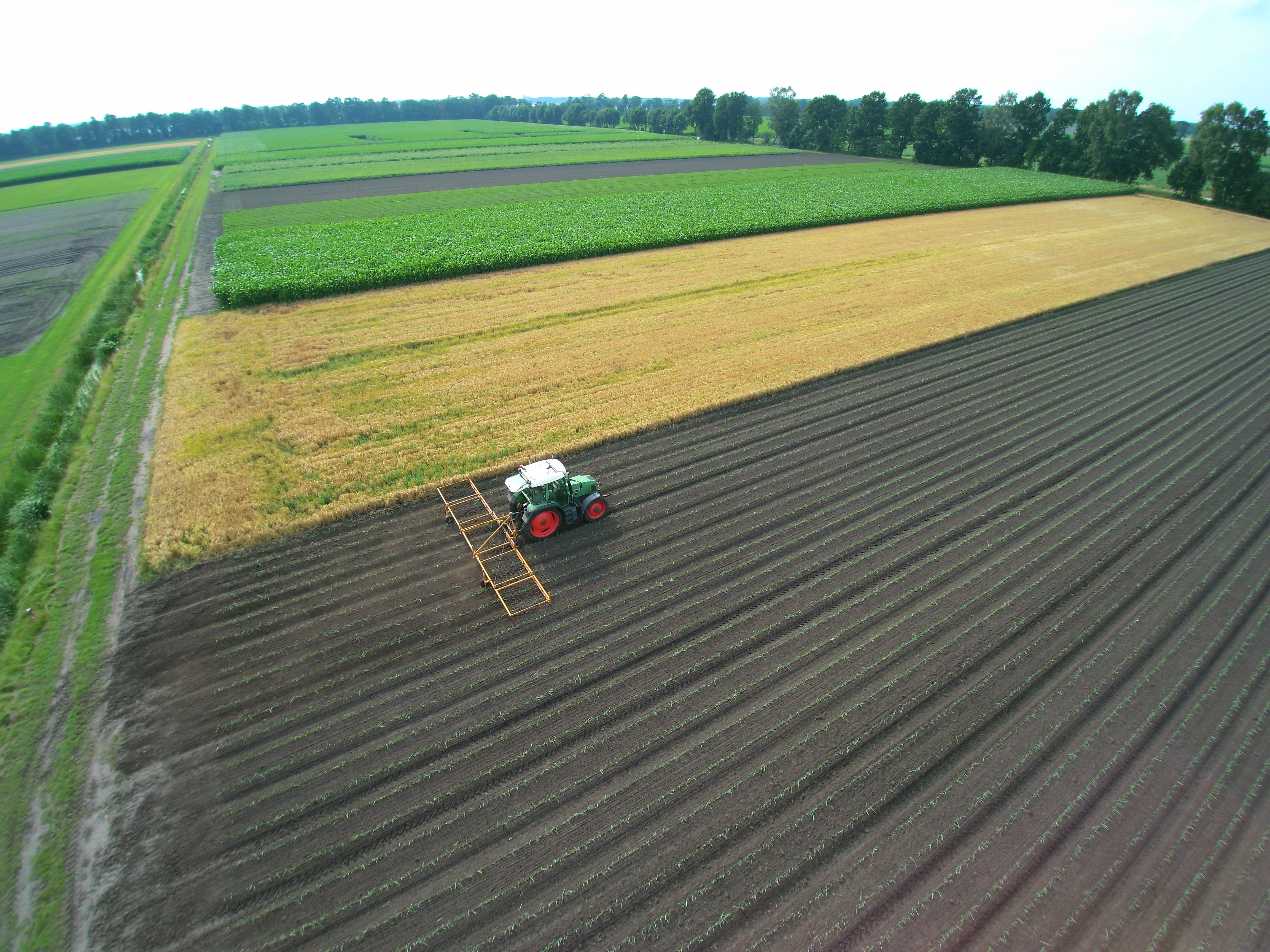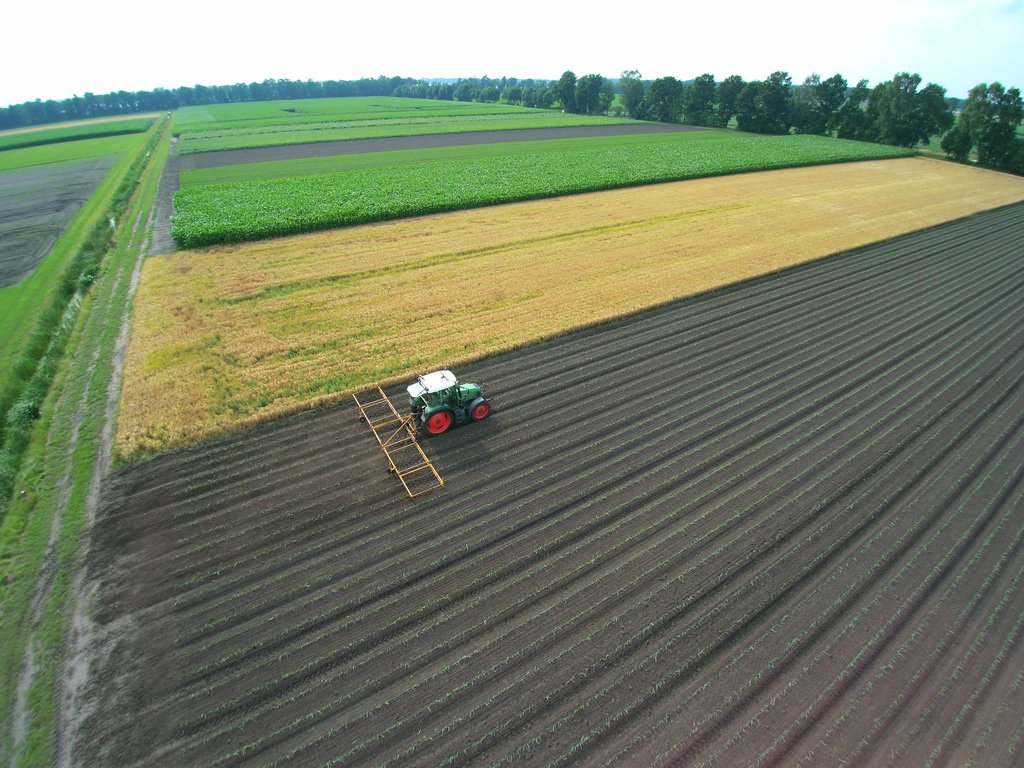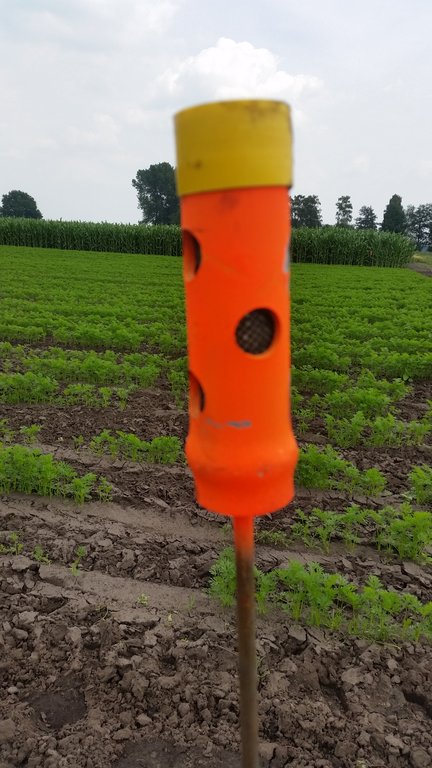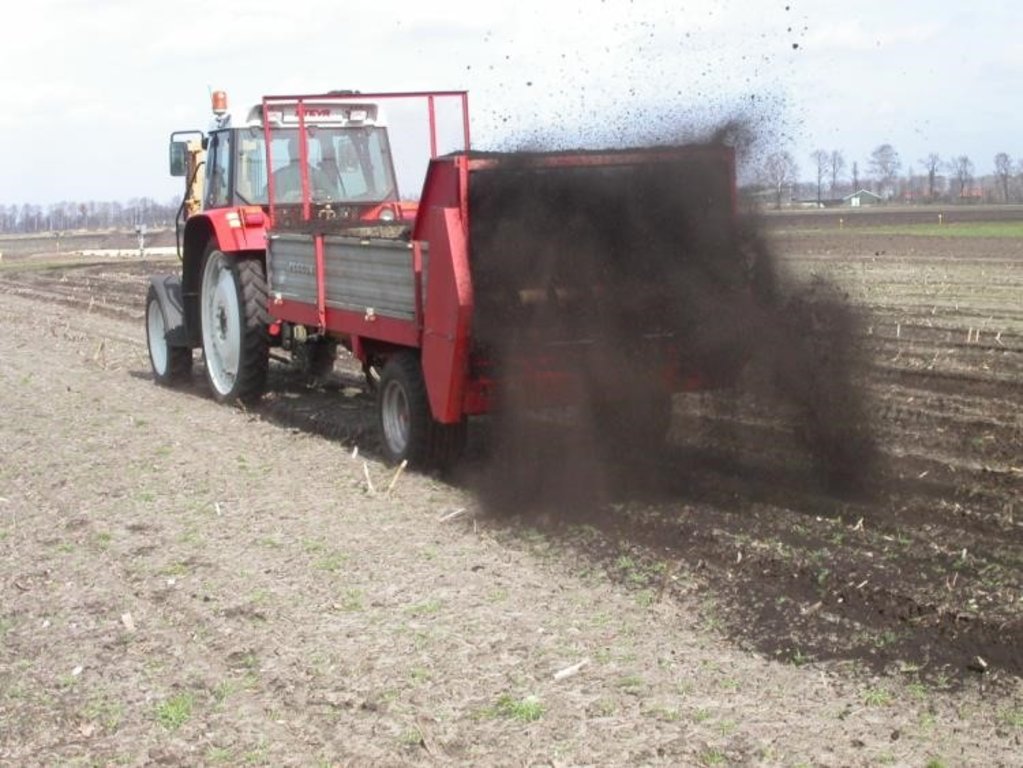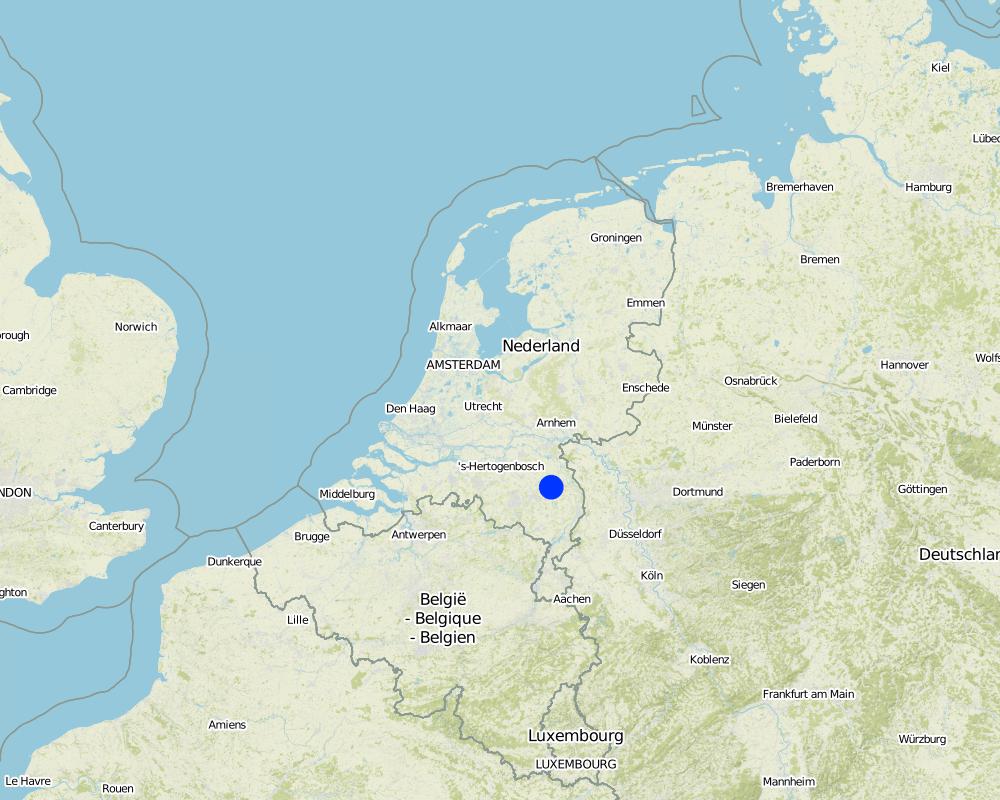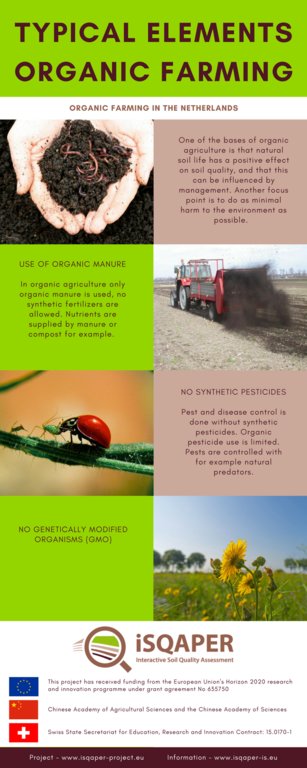Organic agriculture with vegetable and arable crops on sandy soils [荷兰]
- 创建:
- 更新:
- 编制者: wijnand sukkel
- 编辑者: Marie Wesselink
- 审查者: Ursula Gaemperli, Gudrun Schwilch, Alexandra Gavilano
biologische landbouw met groente en akkerbouw gewassen op zandgronden
technologies_2978 - 荷兰
查看章节
全部展开 全部收起1. 一般信息
1.2 参与该技术评估和文件编制的资源人员和机构的联系方式
有助于对技术进行记录/评估的项目名称(如相关)
Interactive Soil Quality assessment in Europe and China for Agricultural productivity and Environmental Resilience (EU-iSQAPER)有助于对技术进行记录/评估的机构名称(如相关)
Stichting Dienst Landbouwkundig Onderzoek, Wageningen University & Research Centre (DLO) - 荷兰1.3 关于使用通过WOCAT记录的数据的条件
编制者和关键资源人员接受有关使用通过WOCAT记录数据的条件。:
是
1.4 所述技术的可持续性声明
这里所描述的技术在土地退化方面是否存在问题,导致无法被认为是一种可持续的土地管理技术?:
否
2. SLM技术的说明
2.1 技术简介
技术定义:
Certified Organic Agriculture (EU standards) with a combination of arable and vegetable crops on sandy soils in the Netherlands
2.2 技术的详细说明
说明:
The technology is applied in a vegetable/arable production system on sandy soils in the Netherlands, but could be applied in various production systems on various soils. There are not directly environmental constraints for the application of certified organic agriculture.
Main characteristics of certified organic production can be found in the standards for organic production in the EU (Council Regulation (EC) No 834/2007). Purpose of the technology is sustainable production in a broad sense. Concerning soil management, focus is on maintaining soil quality and preserving (soil) biodiversity. Major inputs are organic fertilizers. No synthetic fertilizers and no synthetic pesticides are used. In practice in the de Peel region where this technology is applied also the use of 'organic' pesticides is minimal.
The impacts of the technology are:
- a better soil quality in general,
- reduced nitrate emissions to groundwater,
- better water holding capacity,
- and more stable yield which are however on average 20% lower than conventional yield.
Yield reduction is mainly due to pests and diseases. The economic performance of the system is good (better than conventional production).
Land user like this technology because of the good economic result and because it call upon their craftmanship as a farmer. Then again, farmers dislike it because its complicated, and pests are sometimes hard to control and finally because of additional handlabour needed for weed control.
2.3 技术照片
2.5 已应用该技术的、本评估所涵盖的国家/地区/地点
国家:
荷兰
区域/州/省:
De Peel
有关地点的进一步说明:
located close to the village Vredepeel
具体说明该技术的分布:
- 均匀地分布在一个区域
如果不知道精确的区域,请注明大致覆盖的区域:
- 0.1-1 平方千米
Map
×2.6 实施日期
注明实施年份:
1998
2.7 技术介绍
详细说明该技术是如何引入的:
- 通过土地使用者的创新
- 在实验/研究期间
- 通过项目/外部干预
注释(项目类型等):
The rising awareness of the importance of sustainable production and landuse makes that organic farming more and more applied, in research/projects as well as by the farmers themselves.
3. SLM技术的分类
3.1 该技术的主要目的
- 减少、预防、恢复土地退化
- 保持/提高生物多样性
- 适应气候变化/极端天气及其影响
- 创造有益的经济影响
3.2 应用该技术的当前土地利用类型

农田
- 一年一作
年作 - 具体指明作物:
- 谷类 - 大麦
- 谷物类 - 玉米
- 豆科牧草和豆类 - 豌豆
- 根/块茎作物 - 土豆
- 根/块茎作物 - 甜菜
- 蔬菜 - 根茎类蔬菜(胡萝卜、洋葱、甜菜等)
每年的生长季节数:
- 1
注释:
Main crops (cash and food crops): 1:6 rotation: potato, pea, leek, summer barley, sugarbeet, maize
3.4 供水
该技术所应用土地的供水:
- 混合雨水灌溉
3.5 该技术所属的SLM组
- 轮作制度(轮作、休耕、轮垦)
- 土壤肥力综合管理
- 病虫害综合管理(包括有机农业)
3.6 包含该技术的可持续土地管理措施

农艺措施
- A1:植被和土壤覆盖层
- A2:有机质/土壤肥力
- A5:种子管理,改良品种

管理措施
- M2:改变管理/强度级别
3.7 该技术强调的主要土地退化类型

土壤风蚀
- Et:表土流失

化学性土壤退化
- Cn:肥力下降和有机质含量下降(非侵蚀所致)

物理性土壤退化
- Pc:压实

生物性退化
- Bs:质量和物种组成/多样性的下降
- Bl:土壤寿命损失

水质恶化
- Hq:地下水水质下降
3.8 防止、减少或恢复土地退化
具体数量名该技术与土地退化有关的目标:
- 防止土地退化
4. 技术规范、实施活动、投入和成本
4.1 该技术的技术图纸
技术规范(与技术图纸相关):
The most important aspects of organic agriculture are: application of only organic manure and no application of synthetic pesticides, with the idea that soil quality and environment can be positively effected by this.
作者:
Marie Wesselink
日期:
04/10/2017
4.2 有关投入和成本计算的一般信息
具体说明成本和投入是如何计算的:
- 每个技术区域
注明尺寸和面积单位:
50 hectares
其它/国家货币(具体说明):
euro
如相关,注明美元与当地货币的汇率(例如1美元=79.9巴西雷亚尔):1美元=:
0.87
注明雇用劳工的每日平均工资成本:
160
4.3 技术建立活动
| 活动 | 时间(季度) | |
|---|---|---|
| 1. | Change machinery (mainly for weed control) | before during conversion period |
| 2. | stop using synthetic pesticides and nutrient | beforer conversion period |
| 3. | choose conversion period crops | 2 years before start certified organic production |
| 4. | start conversion period (2 years) | 2 years before start certified organic production |
| 5. | design and adapt crop choice and rotation | before and during conversion period |
4.4 技术建立所需要的费用和投入
| 对投入进行具体说明 | 单位 | 数量 | 单位成本 | 每项投入的总成本 | 土地使用者承担的成本% | |
|---|---|---|---|---|---|---|
| 设备 | investments in mechanical weed control machinery | piece | 1.0 | 50000.0 | 50000.0 | 100.0 |
| 技术建立所需总成本 | 50000.0 | |||||
| 技术建立总成本,美元 | 57471.26 | |||||
注释:
Establishement costs are hard to estimate because it depends on the farm specific situation. However there will be a need to adapt the machinery for weed control and also there will be costs (or actually losses in turnover and profitability) in the conversion period because crops grown in the conversion period cannot yet be sold as organic against a premium price.
4.5 维护/经常性活动
| 活动 | 时间/频率 | |
|---|---|---|
| 1. | mechanical weed control instead of herbicides | each cropping season |
| 2. | Handlabour for weed control | each cropping season |
| 3. | Spread of organic fertilisers instead of synthetic nutrients | each cropping season |
注释:
There are a lot of small items that change after adopting organic agriculture. I just mentioned the most relevant ones
4.6 维护/经常性活动所需要的费用和投入(每年)
| 对投入进行具体说明 | 单位 | 数量 | 单位成本 | 每项投入的总成本 | 土地使用者承担的成本% | |
|---|---|---|---|---|---|---|
| 劳动力 | Additional handlabour mostly for weeding | hours | 250.0 | 160.0 | 40000.0 | 100.0 |
| 劳动力 | Additional labour for mechanical weed control | hours | 75.0 | 160.0 | 12000.0 | 100.0 |
| 设备 | yearly costs of weed control mechanisation | euro | 1.0 | 5000.0 | 5000.0 | 100.0 |
| 技术维护所需总成本 | 57000.0 | |||||
| 技术维护总成本,美元 | 65517.24 | |||||
注释:
The additional costs (compared to conventional) and yield losses are most of the time more than covered by additional income because of premium product prices. Costs are calculated for a 50 ha farm.
4.7 影响成本的最重要因素
描述影响成本的最决定性因素:
handlabour for weed control
5. 自然和人文环境
5.1 气候
年降雨量
- < 250毫米
- 251-500毫米
- 501-750毫米
- 751-1,000毫米
- 1,001-1,500毫米
- 1,501-2,000毫米
- 2,001-3,000毫米
- 3,001-4,000毫米
- > 4,000毫米
指定年平均降雨量(若已知),单位为mm:
850.00
注明所考虑的参考气象站名称:
Volkel the Netherlands
农业气候带
- 半湿润
5.2 地形
平均坡度:
- 水平(0-2%)
- 缓降(3-5%)
- 平缓(6-10%)
- 滚坡(11-15%)
- 崎岖(16-30%)
- 陡峭(31-60%)
- 非常陡峭(>60%)
地形:
- 高原/平原
- 山脊
- 山坡
- 山地斜坡
- 麓坡
- 谷底
垂直分布带:
- 0-100 m a.s.l.
- 101-500 m a.s.l.
- 501-1,000 m a.s.l.
- 1,001-1,500 m a.s.l.
- 1,501-2,000 m a.s.l.
- 2,001-2,500 m a.s.l.
- 2,501-3,000 m a.s.l.
- 3,001-4,000 m a.s.l.
- > 4,000 m a.s.l.
说明该技术是否专门应用于:
- 不相关
5.3 土壤
平均土层深度:
- 非常浅(0-20厘米)
- 浅(21-50厘米)
- 中等深度(51-80厘米)
- 深(81-120厘米)
- 非常深(> 120厘米)
土壤质地(表土):
- 粗粒/轻(砂质)
土壤质地(地表以下> 20厘米):
- 粗粒/轻(砂质)
表土有机质:
- 高(>3%)
5.4 水资源可用性和质量
地下水位表:
< 5米
地表水的可用性:
好
水质(未处理):
仅供农业使用(灌溉)
水的盐度有问题吗?:
否
该区域正在发生洪水吗?:
否
5.5 生物多样性
物种多样性:
- 中等
栖息地多样性:
- 中等
5.6 应用该技术的土地使用者的特征
定栖或游牧:
- 定栖的
生产系统的市场定位:
- 商业/市场
非农收入:
- 低于全部收入的10%
相对财富水平:
- 丰富
个人或集体:
- 个人/家庭
机械化水平:
- 机械化/电动
性别:
- 男人
土地使用者的年龄:
- 中年人
5.7 应用该技术的土地使用者使用的平均土地面积
- < 0.5 公顷
- 0.5-1 公顷
- 1-2 公顷
- 2-5公顷
- 5-15公顷
- 15-50公顷
- 50-100公顷
- 100-500公顷
- 500-1,000公顷
- 1,000-10,000公顷
- > 10,000公顷
这被认为是小规模、中规模还是大规模的(参照当地实际情况)?:
- 中等规模的
5.8 土地所有权、土地使用权和水使用权
土地所有权:
- 个人,未命名
土地使用权:
- 个人
用水权:
- 社区(有组织)
5.9 进入服务和基础设施的通道
健康:
- 贫瘠
- 适度的
- 好
教育:
- 贫瘠
- 适度的
- 好
技术援助:
- 贫瘠
- 适度的
- 好
就业(例如非农):
- 贫瘠
- 适度的
- 好
市场:
- 贫瘠
- 适度的
- 好
能源:
- 贫瘠
- 适度的
- 好
道路和交通:
- 贫瘠
- 适度的
- 好
饮用水和卫生设施:
- 贫瘠
- 适度的
- 好
金融服务:
- 贫瘠
- 适度的
- 好
6. 影响和结论性说明
6.1 该技术的现场影响
社会经济效应
生产
作物生产
注释/具体说明:
Up till now, crop production is generally lower in organic agricultural systems compared to conventional systems.
产品多样性
注释/具体说明:
Diversity is enhanced because of more organic matter application, no synthetic pesticide use, and no use of GMOs
收入和成本
农业投入费用
注释/具体说明:
organic planting material and manure are more expensive
农业收入
注释/具体说明:
Organic products can be sold at a higher price if they are certified
工作量
注释/具体说明:
More (hand)weeding is needed because of no pesticide use
生态影响
水循环/径流
水的回收/收集
注释/具体说明:
Due to better soil structure the water holding capacity of the soil increases, but also the natural drainage of the soil improves
土壤
土壤水分
注释/具体说明:
Due to higher organic matter (manure) inputs the water holding capacity of the soil improves
土壤覆盖层
注释/具体说明:
In general, soils used in organic agriculture are covered more months in a year, due to more usage of cover crops in winter season for example
养分循环/补给
注释/具体说明:
More attention is paid to the nutrientcycles, cover crops are used to maintain nutrients for the next season
土壤有机物/地下C
注释/具体说明:
More organic matter is applied, slowly this will lead to a higher content in the soil
生物多样性:植被、动物
植物多样性
注释/具体说明:
No use of pesticides gives the opportunity for a diverse range of plants to develop
有益物种
注释/具体说明:
Pesticides can also harm the beneficial species, no pesticides = more benificial species
栖息地多样性
注释/具体说明:
The whole agricultural system gets more diverse due to more organic inputs and less pesticide inputs
害虫/疾病控制
注释/具体说明:
It is harder to control pests and diseases when synthetic pesticides are not allowed. There is no organic cure for all pests and diseases (yet)
减少气候和灾害风险
干旱影响
注释/具体说明:
Due to better soil structure the soil is less vulnerable for drought events
6.2 该技术的场外影响已经显现
地下水/河流污染
注释/具体说明:
less nitrate leaching
6.3 技术对渐变气候以及与气候相关的极端情况/灾害的暴露和敏感性(土地使用者认为的极端情况/灾害)
气候有关的极端情况(灾害)
气候灾害
| 该技术是如何应对的? | |
|---|---|
| 干旱 | 好 |
6.4 成本效益分析
技术收益与技术建立成本相比如何(从土地使用者的角度看)?
短期回报:
中性/平衡
长期回报:
积极
技术收益与技术维护成本/经常性成本相比如何(从土地使用者的角度看)?
短期回报:
稍微积极
长期回报:
积极
6.5 技术采用
- 1-10%
在所有采用这项技术的人当中,有多少人是自发的,即未获得任何物质奖励/付款?:
- 91-100%
注释:
Adaptation is driving by the mindset that taking good care of soils and environment is very important
6.6 适应
最近是否对该技术进行了修改以适应不断变化的条件?:
否
6.7 该技术的优点/长处/机会
| 土地使用者眼中的长处/优势/机会 |
|---|
| higher income |
| better soil quality |
| more challenging |
| 编制者或其他关键资源人员认为的长处/优势/机会 |
|---|
| more sustainable |
| more resilient |
| lower nitrate leaching |
6.8 技术的弱点/缺点/风险及其克服方法
| 土地使用者认为的弱点/缺点/风险 | 如何克服它们? |
|---|---|
| more handlabour for weeding | improving mechanical weeding techniques, more craftmanship |
| more losses due to pests and diseases | resistant varieties. Robust plants and robust crops. Enhancement natural enemies. more crop diversity |
| more work in marketing the products | better market organisation, cooperation |
| 编制者或其他关键资源人员认为的弱点/缺点/风险 | 如何克服它们? |
|---|---|
| high dependency on abundant (partly conventional) animal husbandry in the region | mixed farms or close cooperation between organic animal farms and arable farms |
| risk of dependency on biopesticides | more resilient production systems, resistant varieties, enhancement natural enemies. Robust plants |
7. 参考和链接
7.1 信息的方法/来源
- 与土地使用者的访谈
The landowner and some of the landworkers were consulted.
- 与SLM专业人员/专家的访谈
The involved researchers were consulted.
(现场)数据是什么时候汇编的?:
20/07/2017
链接和模块
全部展开 全部收起链接
无链接
模块
无模块


